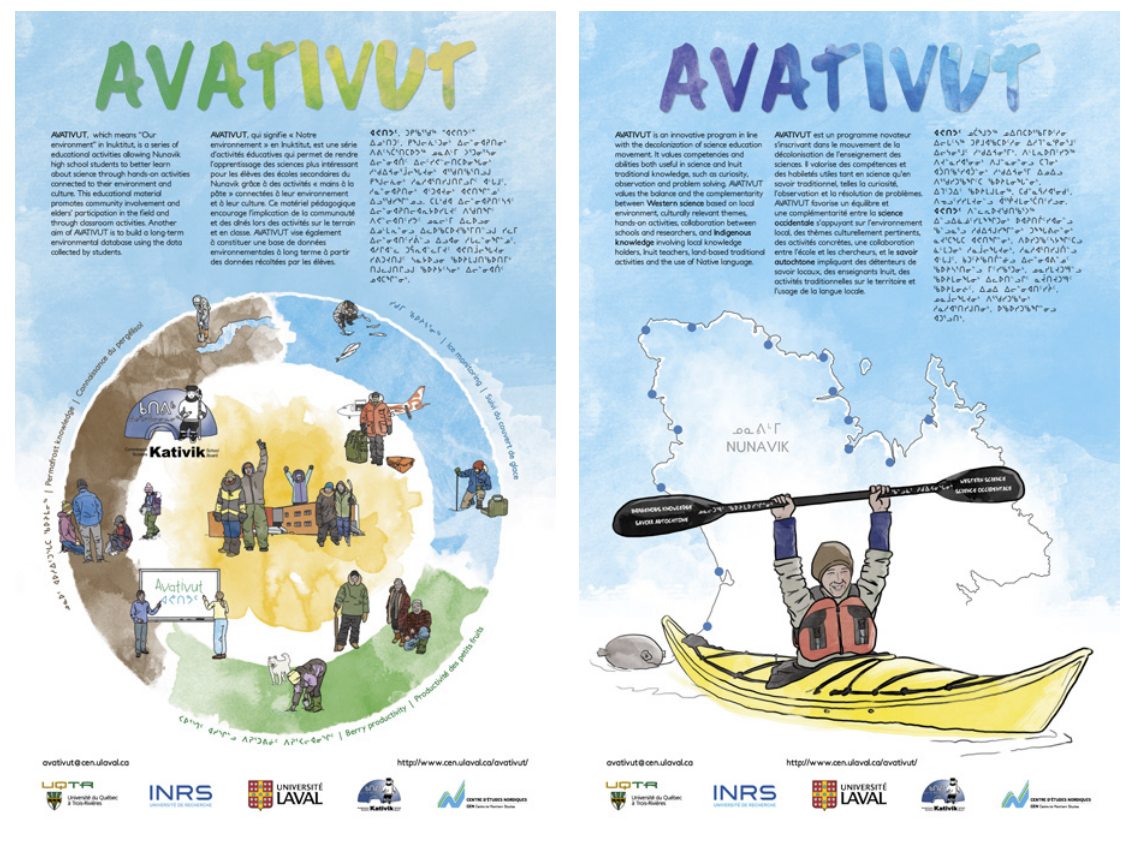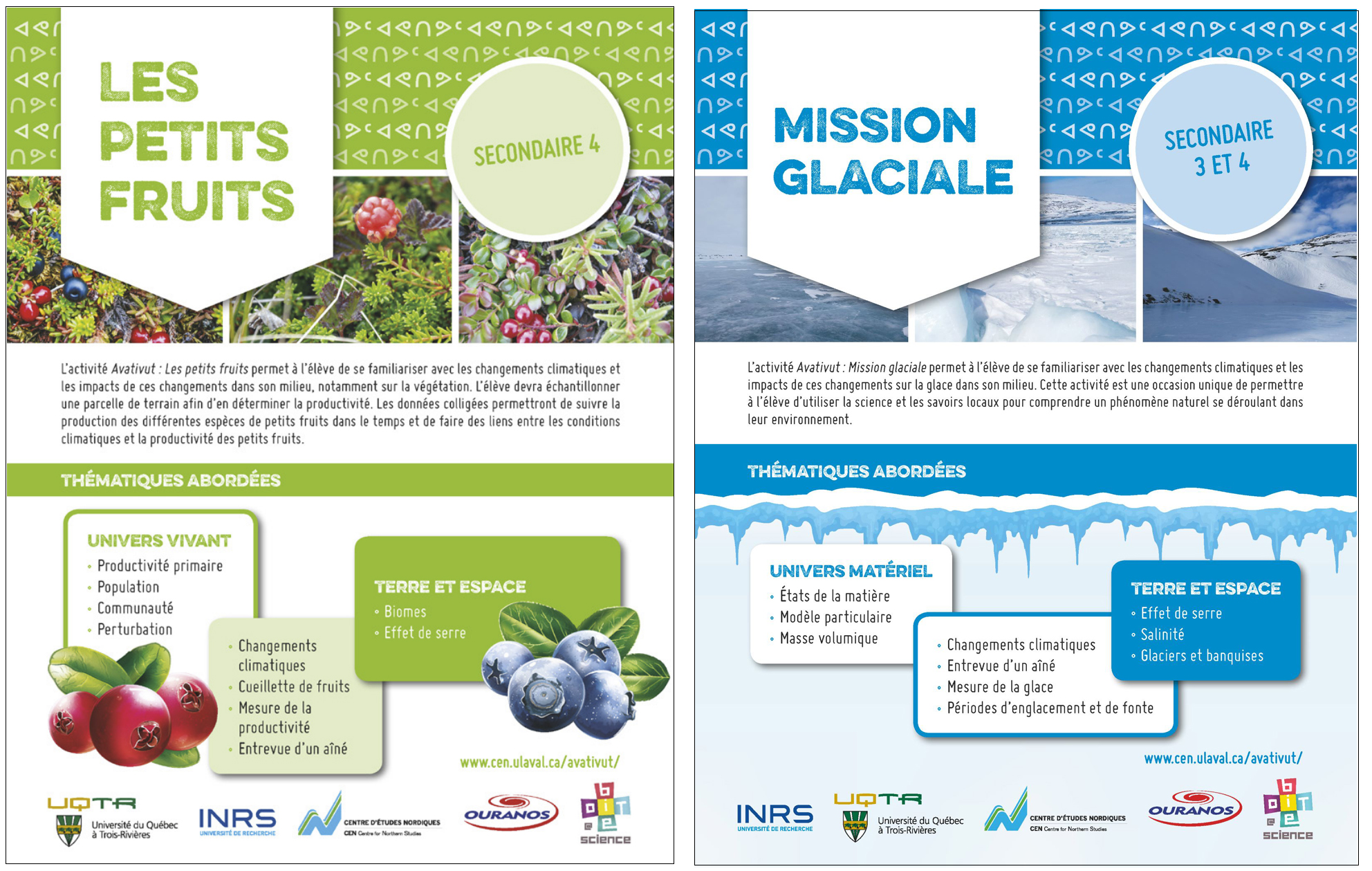AVATIVUT: Environmental Monitoring and Science Education in the Schools of Nunavik
Better adaptation requires understanding. A good understanding requires observation. AVATIVUT educational activities encourage young people to observe their environment and help them understand the impact of climate change.
Project details
Principal(s) investigator(s)

Context
The program Avativut was developed to raise interest among students in Nunavik in natural sciences and to contribute to building a long-term environmental data base. The program involves the active participation of 1,300 high school students from the Kativik School Board, who are enlisted to collect scientific data related to their environment. Learning and evaluation situations (LES) were created and integrated into the curricula of science and technology classes and adapted to Inuit culture and the northern environment.
A network of 48 permanent plots and observation stations distributed across the 14 northern villages of Nunavik was set up to monitor several parameters (vegetation, berry productivity, ice, snow, etc.). Data are collected according to standard protocols developed by scientists and provided to the students within the LES. The Internet portal Avativut allows to archive the data collected and to consult them.
This method encourages exchanges between researchers and students at the regional level. These observations are also used to promote intergenerational dialogue between different domains of knowledge (Inuit Traditional Knowledge and Western Science) that are considered to be of equal and complementary value. The Avativut program is part of a greater movement aiming towards the decolonization of science and science education. However, many challenges remain in order to complete the implementation and ensure the longevity of the program.
Objective(s)
-
Ensure the longevity of the Avativut program and the scientific quality of the resulting environmental database, in order to allow for the monitoring of climate change impacts in Nunavik at the community level.
Methodology
-
Implement more effective and user-friendly mechanisms for the archival of the collected data into the database;
-
Implement tools allowing to visualize the data from the database in a graphic representation and to manipulate and integrate them with other tools;
-
Establish procedures for the validation of the data collected by the students;
-
Improve the processes and means of communicating results;
-
Delegate responsibilities to local resources capable of ensuring the monitoring and continuity of the program.
Results
AVATIVUT Mobile was developed to ensure that the AVATIVUT program was well understood by teachers and properly integrated into the curriculum. The goal of this one-day practical training workshop was to explain and explore AVATIVUT for science and Inuit culture teachers in Nunavik, brainstorm with them to improve the Hands-On Learning Activities (HOLAs), integrate Inuit teachers into the program, and give teachers the opportunity to play the role of students.

The training was offered in four Inuit communities (Salluit, Kangiqsujuaq, Umiujaq and Inukjuak). The interest generated by these workshops was extremely positive. In response to feedback from workshop participants, the Kativik Ilisarniliriniq school board and the project monitoring committee, several aspects of the HOLAs were reworked, such as simplifying the data collection protocols, redesigning and harmonizing interview questions with an elder, and incorporating links to climate change. Three revised HOLAs were delivered to the School Board:
-
How many berries are there?
-
Ice Mission!
-
Permafrost: melting or thawing?
In collaboration with “La boîte à science”, two of these HOLAs were also adapted to be more in line with the Québec school curriculum and to allow their use outside of Nunavik, with a uniform visual signature and assessment tools.

A new version of the Nunavik ground frost and permafrost simulator (PermaSim) was developed in collaboration with Ouranos and Université Laval. This application now includes climate change scenarios for 1995-2015, 2040-2060 and 2080-2099. A tool for visualizing and comparing the data collected by students has also been added. For example, it can plot the productivity of sampled berry plants (g/m²) by species, village and year, and can display this productivity according to climate context.
Thus, while AVATIVUT is primarily intended for Indigenous communities through its links to local environment, culture and knowledge, the program can also be implemented and adapted elsewhere, as long as there are berries, ice or ground frost in the immediate environment. For the time being, the project has led to a reworking of the HOLAs to make them more universal and more in line with the Ministry’s progression of learning goals, such as the climate change component, among others.
However, the work is in constant evolution and the pedagogical material and scientific protocols will always have to reflect the specific reality of the users. Indigenous observation methodologies will be integrated into this evolving and collaborative process as much as possible.
Benefits for adaptation
Benefits for adaptation
Better adaptation requires understanding. A good understanding requires observation. AVATIVUT educational activities encourage young people to observe their environment and help them understand the impact of climate change.
They also promote the transmission and integration of traditional knowledge in this process.
Tomorrow’s decision-makers will thus be more aware and able to support climate change adaptation efforts in Inuit communities.
Scientific publications
Funding






Other participants
-
Institut national de la recherche scientifique (INRS)
-
Université Laval
-
Kativik Ilisarniliriniq